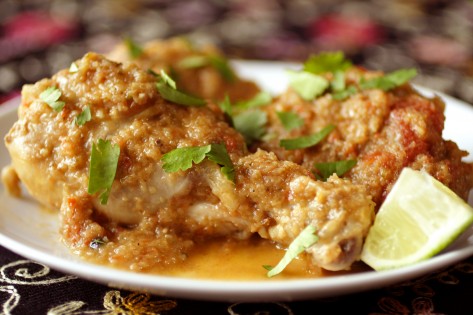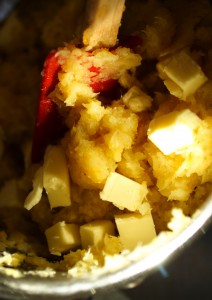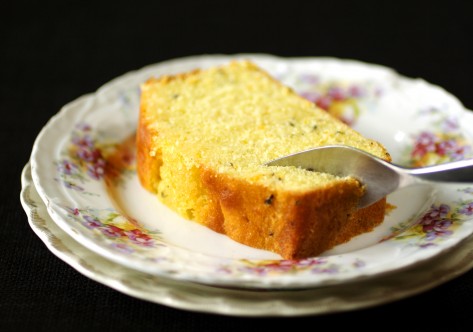Mounting Murgh Makhani

Butter. Pork fat. Poultry fat. Beef and lamb fats.
These are the four chapters that make up Jennifer McLagan’s cookbook Fat, an enjoyable, educational, and entertaining read. It is also an enticing trove of recipes—some sweet and some savory, and some with surprising and original flavor combinations.

Stirring pastured butter into the parsnip and rutabaga puree. Seeing as the best butter is from pastured cows, and that pasture is fueled by the sun, these cubes of butter are captured sunlight.
Starting with the first chapter, “Butter,” I made Butter Parsnips and Rutabaga, a puree flavored with cumin, orange juice and zest, and a generous amount of butter. McLagan says this recipe is the only way she enjoys eating rutabaga, a root vegetable she dislikes but that is much loved by her husband. I’m a rutabaga fan, and so did not need to be converted by her recipe. Yet I was, and have added it to my permanent collection of rutabaga preparations.
With the need to use up some surplus eggs from our laying hens, the recipe for Pepper and Orange Pound Cake was next up. Made with cake flour, McLagan’s recipe is more delicately textured than traditional pound cakes, though it becomes firmer after a couple of days. (McLagan says to let the cake rest overnight before serving; I suggest a couple days, particularly if you like to dunk a piece in dessert wine, as I do.) Its flavor is pleasant, subtle, and not overtly peppery, unless you happen to bite down directly on a speck of pepper.

Pepper and Orange Pound Cake
Perhaps because I’m an Indian food lover, my favorite thus far is her Butter Chicken, or Murgh Makhani (top photo). Authentic Murgh Makhani uses chicken cooked in a tandoor oven, something that is found in Indian restaurants but not in most homes. McLagan’s two-butter version is an elegant solution this problem. In McLagan’s recipe, the chicken is browned in ghee rather than baked. To the same skillet, a spice paste fried to build flavor and aroma, and the bottom of the pan is scraped to “deglaze” it. After a tomato-based sauce is created the chicken pieces are returned to the pan to cook through. The chicken is then removed and at the last minute, off heat, diced cold butter is stirred in—just until melted. This step, known as monter au beurre in French, or “to mount with butter,” gives sauces a thicker body, glossy look, and a rich, buttery flavor.
By using two classic Western cooking techniques—deglazing and mounting with butter—to good effect, I like to think of McLagan’s Murgh Makhani not as an inauthentic Indian dish but, through an original adaptation and deep understanding of cooking techniques, as a authentic Western dish infused with the irresistible flavors of Indian cuisine.
Note: The challenge with making a mounted butter sauce is keeping the butter from separating, as it is beginning to do in my photograph of the dish. One trick to avoid this, I believe, is to make sure the butter is quite cold (taken directly from the fridge); the butter I used had sat out at room temperature while preparing the rest of the dish. And perhaps incorporating the butter bit by bit would be a help. I added all of the butter all at once. Anyone?

Yes Holly You need cold butter and add It bit by bit waiting until each piece is incorporated before adding the next.
1I love the butter swirl as thickening at the end of a dish. The only secret I can think of is that the thickening power of the butter will be negated if the buttered dish is put back over the heat. Its success depends upon that cold (you’re right) butter being not melted but softened… Once it melts the solids separate from the oils.
2I “mount butter” at the ending of a veal stew that involves tiny onions, cannellini beans, and egg noodles, as well as those crunchy little wood ear mushrooms.
Hurrah! Thank you Jennifer for sharing this tip. It’s very helpful. I’m going to try it again adding very cold butter in small amounts.
3Sharon, your comment is useful. It helps to think of the butter as softened (but not melted) and suspended in the sauce. You’ve obviously mastered the process. I’m sure it just takes doing, and doing again, and understanding some basic technique to have success. Your mounted veal stew sauce sounds excellent.
4